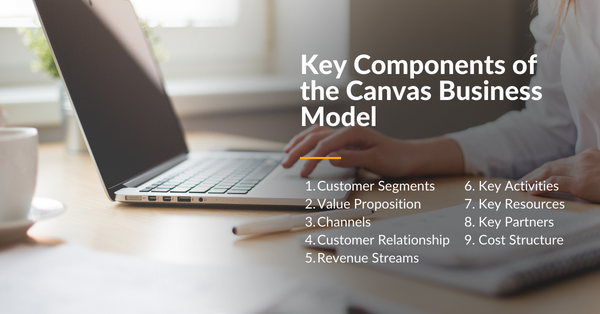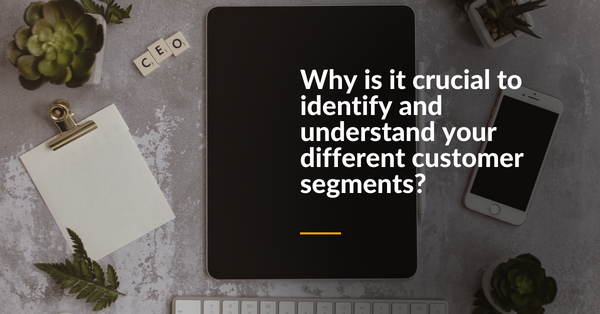Businesses today survive in a highly dynamic environment. Technology has created an elastic world that has seen businesses change and transform in a heartbeat. Business models today are no longer just about your core product or service. They are the way you create value for your customer and how you go about it needs to change. This blog looks at the canvas business model and the key activities involved with it.
What is the canvas business model
The Canvas Business Model is a tool that enables you to visualize, design and update your business model as you go. It helps you identify key elements of your business, so you can develop a clear view of your value proposition, operations, customers and finances to decide where you need to focus your time and attention as you start your online business.
Key Components of the Canvas Business Model
As we have explained in our previous blog on the canvas business model, there are 9 key components of the canvas business model:

1. Customer Segments
Understand who your customers are. Who are you resolving a problem for, or fulfilling a special need? You need to understand them well. What do they need, want, like, and feel? I would advise you before you start filling this in, to do some market research around your customers’ needs so you are crystal clear on your customer’s needs and wants, so you can tailor your business around resolving their problems and challenges.
2. Value Proposition
If you have done some market research about your customers, you should know all about what they are struggling with, what their problems and challenges are. This will help you get clear on what value you are going to deliver to the customer. What problems and challenges are you helping to solve? And what things do you have to offer them for a customer to pick you over your competitor?
3. Channels
Channels are all about where you are communicating with your customers. What platforms are you using to reach out to them? Do you have a website, e-commerce store, social media profile, email marketing platform? Write them all down here. And remember you don’t need to be active on all of these platforms. Choose the ones that work the best for you and your customers.
4. Customer Relationship
Customer relationships will help you get clear on what type of relationship do you have with your customers. How do your customers interact with you from the moment they get interested in your offer, to the time they make a purchase? Is the communication strictly online, is there a dedicated person or a team to manage your customer relationships?
5. Revenue Streams
This is all about how your business makes money. What are your customers willing to pay for and how does that add up to your revenue? For instance, if you are a coach, are you offering online training materials 1:1 coaching sessions, for your services? How are you planning to make money with your business?
6. Key Activities
Key activities are related to your value proposition. What are the key things you need to do in your business in order to deliver the best possible value to your customers? If you are a business coach, problem-solving and customer service will be the key activities you want to focus on to make your customers happy.
7. Key Resources
What resources does your company require to bring your business to life? Do you need physical resources like buildings, vehicles, or machines? Or do you need intellectual resources around building your brand, proprietary knowledge, or creating partnerships? Or do you need human resources to manage your business, or maybe financial help in terms of cash or credit?
8. Key Partners
Key partners are the relationships that you have with other businesses that will help you deliver value to your customers. What external partners do you need to perform your key activities? If you are selling physical products, who are your key suppliers?
9. Cost Structure
The cost structure will help you define all the costs and expenses that your business will incur. Are your costs fixed or variable? You should ask yourself how do your key activities drive your cost structure? If there are any cost components that are not directly linked to your key activities, I would go back and see if these costs are really necessary.
Understanding the Value Proposition
In conclusion, the canvas approach is a powerful tool for entrepreneurs looking to create a winning business model. By visualizing key components such as value proposition, customer segments, revenue streams, and more, you can gain a holistic view of your business and identify areas for improvement. Remember to test and validate your assumptions, gather feedback from potential customers, and refine your business model based on the insights gained. With the canvas approach, you can turn your business idea into a thriving reality and unlock your entrepreneurial potential. So, what are you waiting for? Start mapping out your business model today and embark on the journey to success.
Identifying Customer Segments

According to Cleverism, Customer segments are the community of customers or businesses that you are aiming to sell your product or services to. Customer segments are one of the most important building blocks in the business model canvas for your business, so getting this building block right is key to your success.
Customers can be segmented into distinct groups based on needs, behaviors and other traits that they share. A customer segment may also be defined through demographics such as age, ethnicity, profession, gender, etc or on their psychographic factors such as spending behavior, interests, and motivations. An organization can choose to target a single group or multiple groups through its products and services.
By matching your customer segment to your value proposition, you can achieve a more lucrative revenue stream. Hence, it is fundamental for an organization to understand the trade-off between different customer segments and carefully select which segment it wants to target. Then, the organization must create a value proposition and employ a business model best suited to servicing their chosen customer segment’s needs.
An organization can categorize consumers into distinct groups if they have the following characteristics;
- The customer groups have a particular need which justifies the creation of a product to match this need.
- The group needs a separate Distribution Channel to be reached.
- The groups require relationships of different kinds.
- There is a very clear difference in the level of profitability each group represents for the organization.
- Each consumer group feels strongly enough to pay for a different version of the product or service, tailored to their preferences.
Defining Key Activities
Key Activities and Key Resources share a connection that cannot be broken. Resources serve as accumulations that exert a lasting impact on performance. They can be assets like customers, awareness, trust, or operational capacity.
Key Resources are accumulations that exert a strategic influence on long-term performance. In opposition to key resources, Key Activities are the actions that directly affect the levels of these Key Resources.
While customers may not be considered assets in the traditional sense of ownership, it remains essential to have convenient access to Key Resources, either directly or through a Key Partner, to effectively execute your business model.
Key Activities are those actions that have a discernible impact on the augmentation or diminishment of Key Resources as time goes by Just as the specific Key Resources differ from one business to another, so too will the Key Activities.
Identifying Key Resources

As human scale business explains, Identifying a Key Resource should prompt inquiries about the associated Key Activities, and conversely, recognizing an activity as key should lead to questions about the related resource.
Businesses engage with Key Partners to gain reliable access to Key Resources and/or the capacity to engage in Key Activities. Partnerships can also represent opportunities to share risk. Key partnerships can take a variety of forms, including:
- Strategic alliances
- Joint ventures
- Buyer-seller relationships
Potential partners might enjoy economies of scale or scope or access to resources that would be difficult or impossible to replicate. Their relative advantage creates opportunities for mutually beneficial trade.
A maker of specialty consumer products, for example, might cultivate a special relationship with a design firm in order to ensure the capacity to develop a steady stream of innovative products. In this case, the design firm presumably has proprietary access to a differentiated level of skill—its key resource—that would be difficult for the consumer products company to replicate.
Assessing Revenue Streams and Cost Structure
To build a sustainable business model, you need to define the key activities, resources, and partnerships required to deliver your value proposition effectively.
These elements are essential for ensuring smooth operations and creating a competitive advantage.
Start by identifying the key activities that your business needs to perform to deliver value to your customers. These activities can include product development, marketing, customer support, and more.
Prioritize the activities that directly contribute to your value proposition and focus on optimizing them for efficiency and effectiveness.
Next, identify the resources you need to carry out your key activities.
These resources can be tangible, such as equipment and facilities, or intangible, such as intellectual property or knowledge.
Assess your current resources and determine if you have any gaps that need to be filled
Consider whether you need to acquire new resources or form strategic partnerships to strengthen your business model.
Analyzing the Competitive Landscape

A competitive landscape is a business analysis method that identifies direct or indirect competitors, as Chisel mentions. It helps businesses comprehend their mission, vision, core values, niche market, strengths, and weaknesses.
The goal is to be preventive to competitive business moves instead of responsive. It is a differentiator mindset rather than a similarity that can see companies as another set of data points. The goal is to appreciate what they do and how this affects the industry and customers.
By understanding what competitors do, you can make informed decisions about your own company. The idea is to get a sense of what they do, how they think, and their values.
This analysis should also help you understand what niche markets your competitor is serving and how this affects you.
Testing and Validating the Business Model
Understanding the competitive landscape is very important for creating a winning business model.
By analyzing your competitors, you can identify opportunities for differentiation and develop strategies to outperform them.
Start by identifying your direct competitors – those who offer similar products or services to the same target market.
During your research, the key here is to identify areas for improvement so you can start doing it better.
It’s not enough to know who your competitors are, you need to understand what makes them successful.
Research their marketing strategies, their products, and their weaknesses. This way, you can learn from their successes and take action to improve upon their weaknesses..
Conclusion
Thanks for reading and I hope you enjoyed this article. We’re always excited to bring our readers helpful information, and we appreciate your time and interest in learning more about business. We hope that this information will be helpful in any way, so if you have any questions, please contact us anytime using this form here. We always enjoy hearing from our readers, and look forward to hearing from you.
Thanks for reading, and good luck with your online business!
Before you go, I want to offer you something. It is a 3-month coaching/done-for-you service hybrid program designed to help you create multiple streams of traffic, significantly reduce your content creation time, and increase your passive revenue possibilities without the overwhelm and confusion.
SEO content writing not only helps you create high-quality, keyword-focused content that ranks well in search engines and generates organic traffic to your website, but it also helps you convert that traffic into leads and sales..
With Your Own SEO Content Machine Working For You 24/7, You Can Spend Less Time Marketing & Launching — And More Time Doing What You Love.
You can read more about it here.






0 Comments